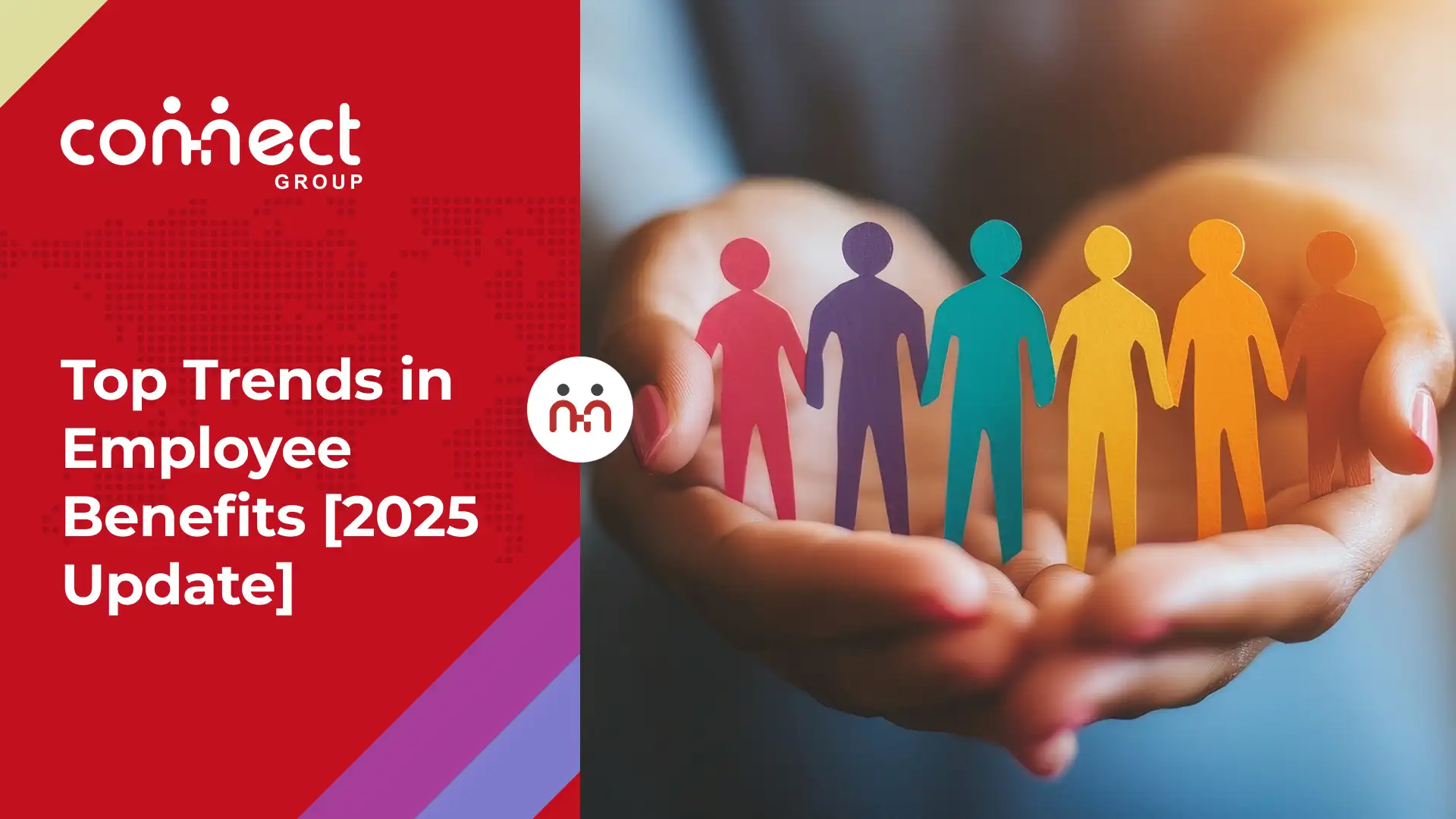A good wage or handsome salary is not enough to attract and retain the best workers. Today, employees also consider the benefits provided to them in addition to their salaries. Things have gone even further over yesteryear. Besides core benefits, as mandated by the UAE labour laws, employees want add-ons that cater to their unique needs and personal circumstances. They want employers to provide them flexibility, a positive and happy culture, and the ability to maintain work-life balance.
In 2025, employee benefits administration will be shaped by changing expectations, technological advancements, economic pressures, and rising health concerns among employees. Employers must pay attention to these factors when curating employee benefits packages to thrive in today’s competitive world.
Here are the employee benefits trends 2025 companies must keep an eye on:
Table of Contents
ToggleAutomation and Employee Benefit Administration
In today’s tech-driven era, no HR aspects, from talent management to payroll processing, are untouched by digitisation. So, employee benefits must not be left behind. Automation is one of the top employee benefits technology trends in 2025.
The pandemic has driven significant benefits digitisation, making companies rethink administration and access to benefits. Nowadays, many businesses are embracing tech platforms to deliver and manage employee benefits. The use of employee benefits technology reduces the burden on HR and benefits administration teams. They can easily streamline processes, leaving them enough time for efforts that have a real impact on manpower. Some common employee benefits management digital tools include HR Management Systems (HRMS) and employee self-service portals.
Here are some ways in which employee benefits technology trends can make a difference:
- Digital benefit platforms have different packages in one place, making it easier for people to understand and leverage available benefits.
- Mobile access helps businesses share information about benefit packages and enables employees to access their benefits easily.
- Automated benefits systems replace towers of paperwork and automate many manual tasks, reducing the chances of errors and bringing accuracy. This is how automation ensures higher compliance with UAE labour laws.
- For every new hire, HR can quickly perform tasks like enrollment, benefits selection, and reporting.
In the future, advanced technologies like Artificial Intelligence (AI) and Machine Learning (ML) will also revolutionise employee benefits management. Some examples of digital benefits include:
AI can automate complex benefits administration tasks, such as enrollment, compliance checks, and claims and renewals management. ML algorithms can provide personalised benefits recommendations based on employee data. This helps employers make informed benefits-related decisions with reduced administrative burden. The accuracy, speed, and personalisation achieved with automation result in a stronger employer and employee experience.
Personalised Employee Benefits Packages
To attract and retain top talent, providing employee benefits is not enough. In fact, companies must offer personalised employee benefits packages. Every person is unique, and so are their needs and preferences. Companies need to understand these needs and provide tailored packages that align with employees’ personal circumstances, financial priorities, and health needs.
Personalised employee benefit packages mean:
- Engage excellent people
- Improve employees morale and productivity
- A positive and inspiring work culture
- Boost employee satisfaction
- Stats from the
2024 Radius Insights research across the Middle East shows that employee benefits are the key to strong employee-employer relationships. As per the report, two-thirds of employees say that companies should offer customised benefits. The same study found that employees’ opinions regarding workplace benefits in the UAE are hardly considered.
In addition to benefits mandated by the UAE labour law, employers can provide optional add-ons covering diverse needs. For this, companies need to listen to their workers and structure compensation packages that help ensure legal compliance and happy employees. Consider factors like industry standards, employee skills and experience levels, organisational budget, Emiratization goals, and UAE labour laws and regulations.
Companies can customise benefit packages for different employee groups per factors like family status, age, or nationality. For example, aged employees may prefer additional healthcare coverage, while young professionals may appreciate work-life balance.
Prioritizing Employee Mental Health Support
Poor mental health among youngsters is a global crisis, and the workplace is one of the major contributors to this challenge. Many global surveys have shown employees blaming their jobs for negative impacts on their mental health. They feel burned out, stressed, lack motivation, low morale, and other signs of declining mental health and wellbeing. So, they expect employee-driven initiatives to help maintain and improve their overall well-being at the workplace. A recent Wellbeing Report 2024 released by Gulf Insurance Group (GIG) suggests that employees desire employer-driven stress management programs and wellness workshops.
For businesses, a significant increase in mental health-related absenteeism is adversely affecting employee productivity and employer’s long-term growth. So, companies need to prioritise mental wellbeing and provide mental health benefits at the workplace as a part of employee benefits administration.
In 2024, the UAE introduced a new Federal Mental Health Law, which prohibits employers from terminating or imposing work restrictions on employees based solely on mental disorders. They must also maintain confidentiality regarding a patient’s mental health status. Beyond these mandated actions, employers should wishfully consider employee wellbeing programs like policy reviews, training and support programs, employee assistance programs and other mental health employee benefits. In the end, both employers and employees will experience mental health benefits like reduced work-related stress, better productivity, work-life balance, increased job satisfaction, and high retention.
Financial Wellness Programs for Employees
According to the 2024 Wellness Barometer Survey, 91% of employees are stressed about finances. Any type of stress can adversely affect employee wellbeing and productivity. That is why companies must take care of their employees’ financial wellness. Workplace financial wellness promotes a healthy company culture. Employees feel valued and empowered as their employer helps them prepare for a better financial future.
Many forward-thinking organisations are already providing financial wellness programs to equip their staff with financial literacy. They get access to resources and tools required to manage their finances effectively and invest wisely. With these initiatives, companies help reduce financial stress among employees and enhance their satisfaction and loyalty. This ultimately results in a more focused and productive workplace.
Start by recognising employee needs because everyone has unique financial goals and wellness levels. Accordingly, provide financial programs that best accommodate their needs. A typical program includes group seminars, masterclasses, and one-on-one sessions with financial experts. Again, this helps attract and retain top talent because financial wellness programs present your company as a leader in employee benefits.
Remote and Hybrid Work Benefits
Remote and hybrid workplaces are no longer the future; they have become the present! Today, hybrid working is one of the top employee benefits people inquire about when applying for a job in a company. It has become a magnet to attract and retain the best talent.
According to a recent survey conducted by International Workplace Group, a hybrid working model results in happier and more loyal employees. The time employees save on long daily commutes on home chores, enjoying their hobbies, caregiving, and self-care. This ultimately results in work-life balance, job satisfaction, and mental health.
Many studies have also shown that hybrid work employee benefits boost productivity. This is because providing workplace benefits of remote or hybrid working increases employees’ morale. They feel valued and cared for, giving them a sense of gratitude for their employer. On the other hand, companies that are unable to offer this benefit struggle to engage and retain quality employees.
So, it is clear – the hybrid model is critical for any company’s growth and success in the post-pandemic era.
Data Analytics in Employee Benefits Administration
As businesses, particularly SMEs (small and medium enterprises), struggle to offer competitive employee benefits, data analytics has become a powerful tool. As we mentioned above, personalisation is perhaps the topmost employee benefits trend in 2025. To achieve this, companies need data-driven insights to deliver benefits packages catering to employees’ needs while maintaining cost-efficiency.
It is worth noting that gathering employee benefits data is more than gathering feedback. You need the right data to make meaningful shifts that have a real impact on your ROI.
Here are some examples:
- Analyse usage data of various wellness programs to determine which are worth the most.
- Tracking short- and long-term disability claims helps figure out workplace health issues and stressors.
- Survey employees to understand their financial concerns and use this data to tailor financial wellness programs.
- Assess historical claim data to predict future costs of benefits
These are just a few examples: Data analytics can be helpful in every aspect of employee benefits administration.
Diversity, Equity, and Inclusion (DEI)
Organisations that embrace DEI support the participation of all groups of individuals, irrespective of their age, gender, ethnicity, race, gender, or disability. Today’s diverse workforce is more inclined towards companies that follow the concept of DEI.
DEI is beneficial for both employers and employees. It improves collaboration, employee satisfaction, engagement, and retention. Achieving DEI demonstrates your company’s commitment to building a positive workplace where everyone feels valued and belongs.
Offer Benefits Your Employees Want in 2025
As an employer, navigating diverse and multi-generation employees can be tricky. However, tailored benefit packages can be a game-changer for your company. Connect Group can help you navigate employee benefits trends in 2025 per UAE labour laws. You will be able to deliver affordable personal, professional, and financial benefits to your workforce in the UAE.
Contact Connect Group to discuss your needs and how to keep up with employee benefits trends 2025.







